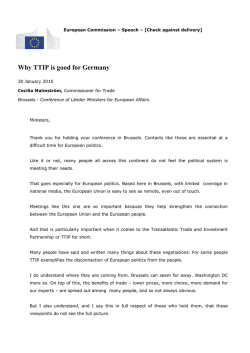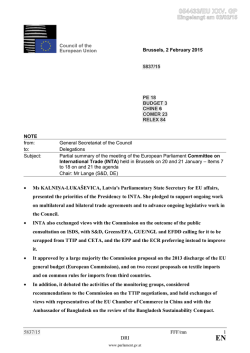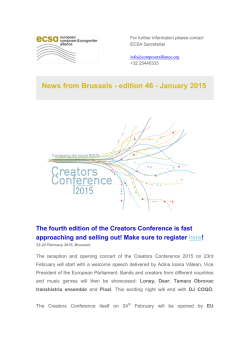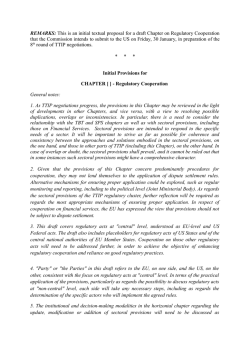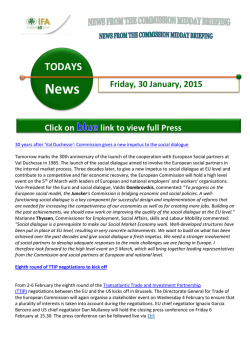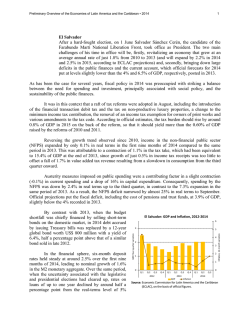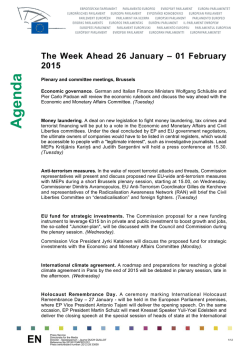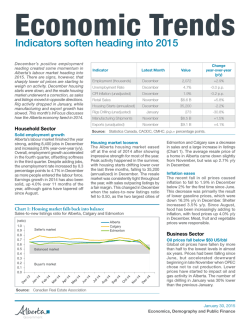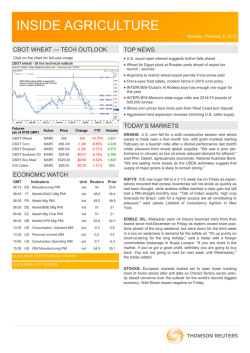
POLICYBRIEF SU MM ARY - European Council on Foreign Relations
POLICY BRIEF EUROPEAN COUNCIL ON FOREIGN RELATIONS ecfr.eu A FRESH START FOR TTIP Sebastian Dullien, Adriana Garcia, and Josef Janning SUMMARY EU member state governments and the European Commission have argued that a Transatlantic Trade and Investment Partnership (TTIP) will reinforce the transatlantic relationship and create growth and employment as a result of better access to the US market and increased competition. But many in Europe see TTIP as a threat to standards, job security, workplace conditions, data protection, and even as a challenge to democratic governance. Opposition is strongest in Germany but has also grown in France, the UK, and other member states, and it may yet prevent an agreement being ratified. What is needed now is a neutral and nuanced discussion of the economic effects of TTIP. The truth is that the partnership is likely to produce losers as well as winners among EU member states. Given public opposition, the EU should make a fresh start in winning support for TTIP. It should seek to quickly reach a narrow agreement that focuses on eliminating remaining tariffs rather than non-tariff barriers. It should seek to make TTIP a “living agreement” scheme to gradually harmonise norms and standards and enable burden-sharing between regulatory bodies in the future. Investor-state dispute resolution should not apply to the transatlantic marketplace. Finally, Europe should consider compensating the losers from TTIP, much as the EU’s structural funds were doubled when the single market was created in 1992. Never before has the European Union negotiated a trade agreement like the Transatlantic Trade and Investment Partnership (TTIP). The EU is used to negotiating with smaller trade partners who are forced to adapt to its own preferences, norms, standards, and proceedings. It has never concluded an agreement with a partner of equal market size as, and of even greater political weight than, itself. As a result of this, as well as of perceptions of the United States in Europe as a possible threat to its norms and values, TTIP has also become the most controversial trade agreement the EU has ever negotiated. Vehement public opposition now threatens TTIP, which could go the way of previous EU-US agreements such as the SWIFT agreement and the Anti-Counterfeiting Trade Agreement, both of which were rejected in the European Parliament. Opposition is strongest in Germany – where, fuelled in part by anti-Americanism, 1.2 million people signed a “Stop TTIP” petition in just ten weeks – and in Austria. But there has also been increasing opposition in France, the Netherlands, Spain, and even the UK – traditionally the most Atlanticist EU member state. TTIP has become a symbol of “hyper-globalisation”, of deepening social cleavages, and of the subordination of public goods to corporate profits. In Germany in particular, opposition has focused on the issue of investor-state dispute settlement (ISDS) clauses, which has now replaced chlorinated chicken as a popular symbol of the threat from TTIP. Public fear and anger has also focused on data protection, health and environmental norms and standards, and the possible impact on public services such as the National Health Service in the UK. A FRESH START FOR TTIP Given the commitment of European leaders to the project, the stakes are high. From the beginning, European leaders made the case for TTIP in strategic as well as economic terms. Against the background of the financial and euro crises, policymakers in Germany, the UK, and the US conceived of the project as a means of challenging the prevalent narrative of Western decline. Specifically, they saw it as a way to create growth through the structural reforms in Europe that would be triggered by a free trade agreement, to sustain the transatlantic relationship by signalling commitment and ambition, and to set global norms, standards and rules on trade. If TTIP now fails, it would confirm precisely the perception it was meant to challenge. This brief argues that, with trust in the US at a low and acceptance of the EU’s policies and institutions in decline, the new European Commission needs to make a fresh start in winning public support for the project. In particular, a neutral and nuanced discussion is needed about the economic impact of TTIP, which will create winners and losers in Europe. The European Commission also needs to take seriously concerns about ISDS clauses, which have become the focus of opposition to TTIP, particularly in Germany. In the light of the difficulties with reaching a comprehensive deal that reduces non-tariff barriers (NTBs), the European Commission should consider whether to lower its ambition and seek a narrower deal that focuses on removing the remaining tariffs in trade between the EU and the US. ECFR/124 February 2015 www.ecfr.eu The economic impact of TTIP on EU member states 2 Supporters of TTIP in Europe argue that it will help create economic growth and create jobs. In 2013, for example, Trade Commissioner Karel De Gucht declared that an ambitious deal could produce “a growth boost for Europe in the region of €120 billion” that would translate into “millions of new jobs for our workers”.1 Europe could benefit from the rebound in the US economy at a time when the eurozone is still struggling and could tap into US energy resources if an agreement ended current export restrictions of US oil and gas. Supporters of TTIP see it in win-win terms: a deal that reduced tariffs and NTBs on both sides of the Atlantic would benefit both Europe and US and all member states within the EU. In short, there would be no losers from TTIP. In reality, however, the economic impact of TTIP is likely to be less dramatic and its benefits more unevenly distributed within the EU than its supporters suggest. Most serious research on TTIP concludes that the macroeconomic effect on the EU as a whole would be relatively modest. For example, the French CEPII institute predicts that a comprehensive TTIP (in other words, one that reduces non-tariff barriers as well as tariffs) could increase the level of EU GDP by 0.3 percent over the 1 “Transatlantic Trade and Investment Partnership (TTIP) – Solving the Regulatory Puzzle”, Speech by Karel De Gucht at The Aspen Institute Prague Annual Conference, Prague, 10 October 2013, available at http://europa.eu/rapid/press-release_ SPEECH-13-801_en.htm. long run and a less comprehensive TTIP (in other words, one that only reduced tariffs) by less than 0.1 percent.2 According to the British CEPR institute, an ambitious, comprehensive TTIP could increase EU GDP by 0.5 percent by 2027 and a less comprehensive treaty by 0.1 percent.3 Two German studies – one by the German Ifo Institute on behalf of the Bertelsmann Foundation and another by the German Ministry of Economics – see a much bigger potential effect of a comprehensive TTIP. But these studies have been widely criticised for their methodology. In particular, the assumption that TTIP would increase trade with the US by 80 percent has been widely judged to be “clearly unrealistic”.4 The impact on individual EU member states is also likely to vary. The European Commission is negotiating on behalf of 28 member states that have rather different economies. Some of them will likely gain from TTIP, but others could see trade diverted. In particular, because the 28 member states already form a single market and hence enjoy preferential access to each other’s markets, forming a free trade area with the US means that European companies will lose part of their relative advantage over US-based competitors in other parts of the EU market. For example, if tariffs on imports of US textiles were removed, textile producers from Romania would face fiercer competition in the German market from US competitors. As this example illustrates, the impact of TTIP is likely to affect different sectors of the economy in different ways. According to most studies, the European manufacturing sector stands to profit most.5 The biggest winner of all could be the European automobile industry, which is particularly competitive relative to its US counterpart and would experience important output and export increases. Other industries that would experience an important increase in total and bilateral exports to the US include chemicals, cosmetics and pharmaceuticals, metals and metal products, other transport equipment, miscellaneous manufactures, and wood and paper products. On the other hand, output losses are predicted for sectors that would be challenged by the reduction of tariffs, such as electrical machinery, metals and metal products, and aerospace. 2 See Lionel Fontagné, Julien Gourdon, and Sébastien Jean, “Transatlantic Trade: Whither Partnership, Which Economic Consequences?”, Centre d’Études Prospectives et d’Informations Internationales, September 2013, available at http://www.cepii.fr/ PDF_PUB/pb/2013/pb2013-01.pdf (hereafter, Fontagné et al., “Transatlantic Trade”). 3 See Joseph Francois, Miriam Manchin, Hanna Norberg, Olga Pindyuk, and Patrick Tomberger, “Reducing Trans-Atlantic Barriers to Trade and Investment: An Economic Assessment”, Centre for Economic Policy Research, March 2013, available at http:// trade.ec.europa.eu/doclib/docs/2013/march/tradoc_150737.pdf (hereafter, Francois et al., “Reducing Trans-Atlantic Barriers to Trade and Investment”). 4 Jacques Pelkmans, Arjan Lejour, Lorna Schrefler, Federica Mustilli, and Jacopo Timini, “The Impact of TTIP: The underlying economic model and comparisons”, Centre for European Policy Studies, October 2014, p. 4, available at http://www.ceps.eu/book/ impact-ttip-underlying-economic-model-and-comparisons. 5 See Francois et al., “Reducing Trans-Atlantic Barriers to Trade and Investment”; Koen G. Berden, Joseph Francois, Martin Thelle, Paul Wymenga, and Saara Tamminen, “Non-Tariff Measures in EU-US Trade and Investment: An Economic Analysis”, ECORYS, 2009, available at http://trade.ec.europa.eu/doclib/docs/2009/december/ tradoc_145613.pdf (hereafter, Berden et al., “Non-Tariff Measures in EU-US Trade and Investment”); Fredrik Erixon and Matthias Bauer, “A Transatlantic Zero Agreement: Estimating the Gains from Transatlantic Free Trade in Goods”, European Centre for International Political Economy, October 2010, available at http://www.ecipe.org/app/ uploads/2014/12/a-transatlantic-zero-agreement-estimating-the-gains-from-transatlantic-free-trade-in-goods.pdf. The European service sector could also benefit from TTIP – perhaps even more than the US service sector.6 Again, sub-sectors in which Europe is traditionally strong would benefit the most. The insurance business has been identified as a clear winner in terms of production and exports. Construction, business services, water transport, and financial services would also benefit from output and export increases. The agricultural sector, on the other hand, could see a loss in value-added. Average tariffs on agricultural products are higher than for manufactured goods and there are also NTBs, which together mean that European exporters of food and beverages to the US face an additional trade cost equivalent to 73.3 percent – the highest for all sectors.7 Although in this respect the European agriculture sector would benefit from TTIP, it would also lose the protection it currently enjoys. While, according to one study, US exports to the EU after TTIP would increase by 116 percent, EU exports to the US market would increase by only 56 percent.8 Intra-EU exports would also decrease by 2.1 percent and the total net fall of EU agricultural valueadded is estimated at 0.5 percent. There could be export opportunities for the EU in dairy products, processed products (including wine and spirits) and, under certain conditions, sugar and biodiesel, but adverse competitive effects in sectors such as beef, ethanol, poultry, and cereals. The impact of TTIP on individual EU member states will also depend on the importance of small and medium-sized enterprises (SMEs) in their economies. Trade agreements tend to have a different impact on companies of different sizes. Traditional trade agreements that focus on reducing tariffs tend to benefit large companies more. In particular, because SMEs usually have no specialised departments to deal with the rules-of-origin that come with traditional trade agreements, they often continue to export under previous non-preferential most-favoured-nations tariffs.9 Although TTIP negotiators are discussing a specific SME chapter – something that is unprecedented for the EU – studies and business surveys indicate that larger firms would profit most from tariff reduction in this case too.10 But SMEs, which have limited resources and experience in dealing with issues such as different regulations and registration requirements in different jurisdictions, would benefit most from a reduction in NTBs.11 6 See Francois et al., “Reducing Trans-Atlantic Barriers to Trade and Investment”, p. 60; Fontagné et al., “Transatlantic Trade”, p. 9. 7 See Berden et al., “Non-Tariff Measures in EU-US Trade and Investment”, p. 24. 8 Jean-Christophe Bureau, Anne-Célia Disdier, Charlotte Emlinger, Jean Fouré, Gabriel Felbermayr, Lionel Fontagné, and Sébastien Jean, “Risks and Opportunities for the EU Agri-Food Sector in a Possible EU-US Trade Agreement”, European Parliament, Directorate-General for Internal Policies, September 2014, available at http://www.europarl.europa.eu/RegData/etudes/STUD/2014/514007/AGRI_IPOL_STU%282014%29514007_ EN.pdf. 9 Rules-of-origin usually state that a certain percentage of a product’s value-added needs to originate in the territories of the contracting parties in order to qualify for a free trade area’s preferential tariffs. 10 See European Commission, “EU-US trade negotiators explore ways to help SMEs take advantage of TTIP, as fourth round of talks ends in Brussels”, Brussels, 14 March 2014, available at http://europa.eu/rapid/press-release_IP-14-272_en.htm; Gabriel Felbermayr, Mario Larch, Lisandra Flach, Erdal Yalcin, and Sebastian Benz, “Dimensionen und Auswirkungen eines Freihandelsabkommens zwischen der EU und den USA”, Leibniz-Institut für Wirtschaftsforschung, January 2013, available at http://www.bmwi. de/BMWi/Redaktion/PDF/Publikationen/Studien/dimensionen-auswirkungen-freihan delsabkommens-zwischen-eu-usa-summary,property=pdf,bereich=bmwi2012, sprache=de,rwb=true.pdf. 11 See Garrett Workman, “The Transatlantic Trade and Investment Partnership: Big Thus the effect of TTIP on individual EU member states will depend above all on the structure of their economies and in particular on the existing degree of protection for specific exports. Specifically, member states that specialise in exporting in sectors that currently have high tariffs will benefit more than member states that specialise in exporting in sectors with low tariffs. For example, while tariffs on Bulgaria’s top exports to the US – mainly tobacco – average more than 10 percent, tariffs on Luxembourg’s average a mere 0.28 percent. Even between countries with similar per capita incomes, existing rates of tariffs are quite different: while tariffs on France’s top exports average 0.69 percent, tariffs on Germany’s average 1.65 percent; whereas tariffs on Portugal’s exports (which include bed linen, on which there are tariffs of up to 20 percent) average 4.62 percent, they average only 0.66 on Slovenia’s exports. In addition to the existing levels of tariffs on exports, the impact on individual member states will also depend on existing trade linkages with the US. In particular, countries that export more to the US will benefit more. For example, Ireland sends more than 20 percent of its exports to the US; some of the new member states such as Latvia, Bulgaria, or Slovenia, on the other hand, send less than 2 percent. Ireland’s exports to the US amount to more than 10 percent of its GDP; Cyprus’s exports to the US contribute only 0.35 percent to its GDP. Another factor in determining the impact of TTIP on member states is trade complementarity with the US. In particular, countries that produce goods and services that the US tends to import are more likely to gain. For example, while 50 percent of Germany’s exports overlap with the goods and services that are imported by the US, only 16 percent of Cyprus’s exports do. A final factor is trade substitutability with the US. Specifically, countries that export goods and services to the rest of the EU that are also exported by the US might lose, as they will face more competition within the EU market – as in the case of Romanian textile producers. Thus a number of different factors will determine the economic impact of TTIP on EU member states (see figure 1). According to our data, some of the small countries such as Estonia, Denmark, and Portugal are well positioned to gain from TTIP, followed by large countries traditionally seen as potential winners. This is in line with other studies (which often do not include detailed statistics for the smaller EU member states). Macroeconomic studies suggest that Germany and the UK – the two EU member states that pushed for TTIP – are unsurprisingly likely to benefit most. The CEPII study found that Germany and the UK will make GDP gains of 0.4 percent by 2025 – twice the expected increase for France and newer EU member states.12 The UK would increase the volume of its exports by 4 percent, with France and Germany close to the EU average of 2 percent and new member states below that. Opportunities for Small Business”, Atlantic Council, November 2014, available at http:// www.atlanticcouncil.org/images/publications/TTIP_SME_Report.pdf. 12 See Fontagné et al., “Transatlantic Trade”. 3 A FRESH START FOR TTIP Figure 1: TTIP Potential Benefit Index Member state ECFR/124 February 2015 www.ecfr.eu Estonia Denmark Portugal Germany Italy Lithuania Netherlands Spain UK Finland Ireland Sweden Belgium Cyprus Hungary Slovakia Austria Bulgaria Czech Rep. Poland Croatia France Greece Malta Romania Latvia Luxembourg Slovenia 4 Exports to US as share of total exports (%) 3.47 5.2 4.22 8.08 6.96 2.79 3.88 3.71 11.46 6.07 21.16 5.82 5.14 3.58 3.04 1.81 5.36 1.37 2.17 2.24 2.75 6.31 3.42 4.34 1.67 1.18 3.41 1.69 Exports to US as share of GDP (%) 2.59 1.74 1.21 3.24 1.73 1.98 2.77 0.85 2.49 1.76 11.21 1.74 5.17 0.35 2.52 1.61 2.14 0.76 1.76 0.87 0.57 1.31 0.51 2.34 0.58 0.51 0.78 1.04 Exports to Trade SubstituCompletionality (S) mentarity (C) (0-1) (0-1) 0.315 0.379 0.318 0.53 0.428 0.319 0.501 0.403 0.527 0.328 0.232 0.447 0.467 0.168 0.389 0.332 0.419 0.28 0.405 0.38 0.284 0.485 0.288 0.21 0.308 0.314 0.219 0.346 0.339 0.411 0.355 0.519 0.438 0.337 0.453 0.421 0.505 0.279 0.2 0.423 0.417 0.197 0.406 0.403 0.407 0.298 0.438 0.398 0.273 0.444 0.219 0.152 0.345 0.316 0.196 0.321 Summary measure (trade S minus trade C) 0.02 0.03 0.04 -0.01 0.01 0.02 -0.05 0.02 -0.02 -0.05 -0.03 -0.02 -0.05 0.03 0.02 0.07 -0.01 0.02 0.03 0.02 -0.01 -0.04 -0.07 -0.06 0.04 0 -0.02 -0.03 Tariff on top 10 exports tradeweighted average (%) 5.19 2.42 4.62 1.65 2.12 5.68 3.49 3.47 1.99 2.46 1.48 1.64 1.76 2.09 1.1 2.45 1.02 11.1 1.16 2.22 2.23 0.69 4.74 0.99 1.57 1.31 0.28 0.66 Overall score (0-10) 10 9 9 8 8 8 8 8 8 7 7 7 6 6 6 6 5 5 5 5 4 4 4 4 4 3 2 2 TTIP Winners and Losers Overall Score 10 9-8 7-6 5 4-3 2 Methodological note While data exists in a straightforward way directly from statistical offices for some of the structural factors determining countryspecific benefits from TTIP discussed in this brief, for some other factors indicators had to be constructed. In order to measure trade linkages, we have included indicators of exports to the US as share of total exports (how important the US is for the trading sector) and as share of GDP (how important the US is for a member state’s economy as a whole). In order to measure trade complementarity, we have used the trade complementarity index (TCI) pioneered by Michael Michaely.1 This index measures how far the basket of exports of one country matches the basket of imports of a partner country: a value of 1 indicates perfect complementarity; an index of 0 indicates that there are no overlaps between the exports of one country and the imports of the other country. The larger this trade complementarity between an EU member state and the US, the larger are potential gains from TTIP. In order to measure trade substitutability, we have constructed a trade substitutability index (TSI), which is similar to the TCI index but measures how far an EU member state’s exports to other EU member states overlap with the US’s own exports. A value of 1 here indicates that an EU member state exports to its EU partners exactly the same goods and services that the US exports to the world, implying a larger negative impact for this country through increased competition by American companies. A value of 0 indicates that there is no overlap between the EU member state’s intra-EU exports and the US’s own exports, and hence no potential for negative competition effects. Trade substitutability generally shows a strong correlation to trade complementarity, meaning that countries that have large opportunities to benefit are also those countries that will face strong competition with US exports in other EU markets. However, the balance between the two (which can be seen as a summary for new export opportunities and increased export pressure) again differs strongly. For example, for Denmark and Portugal, this summary measure indicates more opportunities in the US market than challenges in the EU market; for Greece, France, Malta, and Finland, the indicator hints at more challenges than opportunities. In order to measure the existing degree of protection for country-specific exports, we have calculated the trade-weighted average tariff rate for a country’s exports to the US.2 When this rate is high, a removal of all trade barriers would benefit a country more than when it is very low. The reduction of tariffs is especially important in markets in which SMEs are exporting and in which they have to act to a certain degree as a price taker. In these cases, a reduction of tariffs can be expected to directly increase the profit margin of the companies concerned as they can keep their prices in the US market unchanged but receive a higher profit per unit. This could be the case for the shoe industry, which faces an average tariff rate for exports to the US of more than 5 percent. In order to calculate the overall score, we first created an aggregate score (trade substitutability minus trade complementarity) in order to compare the share of an EU member state’s exports that might benefit from TTIP to the share of exports to the rest of the EU that might face stronger competition from US exporters. Then, for each of the four indicators, member states are ordered in terms of their scores and given points (from 0 to 3) based on the quartile in which they find themselves. (For example, Germany’s exports to the US amount to 3.24 percent of its GDP, the third-highest proportion among EU member states and hence in the top quartile. It therefore gets 3 points for this indicator.) Finally, the points are added up to generate a final score. This final score should therefore be understood in relative terms: the more points a country scores, the greater its potential to gain from TTIP relative to other member states. 1 See Michael Michaely, “Trade Preferential Agreements in Latin America: An Ex-Ante Assessment”, the World Bank, March 1996, available at http://www-wds.worldbank.org/ servlet/WDSContentServer/WDSP/IB/1996/03/01/000009265_3961019193227/Rendered/PDF/multi0page.pdf. 2 Calculations are based on the top 10 export products (at the HS 6-digit level) of EU member states from the WITS-UNSD Comtrade database, and the MFN applied tariffs reported by the US to the WTO in 2013. Where tariffs were expressed in a non-ad valorem form, ad valorem equivalents computed by the World Bank and UNCTAD were used. The trade-weighted average was obtained by calculating the percentage of trade in each of the top 10 export items that is subject to tariffs. 5 A FRESH START FOR TTIP However, our research suggests that countries such as Italy and Spain could also benefit greatly from TTIP. They already trade extensively with the US but face significant tariffs on their exports, their export structure aligns well with the import structure of the US, and there is little danger of increased competition from American exporters into the EU market. Conversely, some other EU member states score badly in all respects. A good example is Slovenia. It trades very little with the US and the contribution to its GDP of trade with the US is small. In addition, its own exports to the rest of the EU are more similar to US exports than Slovenia’s exports are similar to the US’s imports. It can therefore be assumed that Slovenia will be negatively impacted by additional competition from US exports in the EU market, while having limited potential of its own to export more to the US. Moreover, tariffs for its top 10 exports to the US are already very low; hence tariff reduction is not likely to provide much of a boost for its economy. In short, TTIP is likely to produce losers as well as winners among EU member states – something on which little attention has so far focused. The backlash against TTIP Much of the public criticism of TTIP has focused on the perceived intransparency of the negotiations. In democratic societies, the accusation of intransparency is a powerful tool in the hands of actors who seek to delegitimise processes and actors – particularly when there are low levels of trust in politics and institutions. Under such conditions, elite-driven projects tend to reinforce mistrust of people who feel their preferences, jobs or lifestyles are threatened. In this sense, the negotiation process has so far played into the hands of the sceptics. As in most negotiations, the process started with little to no inclusion of civil society and on the basis of confidential negotiating positions. The European Commission initially dismissed critics as uninformed and as unrepresentative of Europe, which backfired badly on the Commission – a body of unelected bureaucrats. At a later stage, the Commission’s denial that TTIP would become a “mixed agreement”, thus requiring ratification in all member state parliaments, further fuelled the opposition. There is now an organised campaign against TTIP based on a “Dracula strategy” – that is, to force it into the sunlight. When the European Commission launched a public consultation on ISDS, it received 150,000 responses.13 According to the Commission, about 145,000 of the responses were “submitted collectively through various online platforms containing pre-defined answers which respondents adhered to”.14 Whereas former Trade Commissioner Karel De Gucht called the mass submissions an “attack” on the 13 See European Commission, “Online public consultation on investment protection and investor-to-state dispute settlement (ISDS) in the Transatlantic Trade and Investment Partnership Agreement (TTIP)”, July 2014, available at http://trade.ec.europa.eu/ doclib/docs/2014/july/tradoc_152693.pdf. The results of the consultation had not been made public by the European Commission at the time of writing (December 2014). 14 Commission Staff Working Document of 13 January 2015, SWD (2015) 3 final, available at http://trade.ec.europa.eu/doclib/docs/2015/january/tradoc_153044.pdf. Impact on member states: What other studies say Austria An Austrian study predicts a prospective increase of 1.7 percent in national income and of 44 percent in exports to the US.1 The largest output gains would occur in the motor vehicles sector, followed by various service sectors (construction, business services, insurance), textiles and clothing, and processed foods. Output declines are predicted for other transport equipment and “other goods”. Sectors with strong bilateral export growth would include textiles, transport equipment, motor vehicles, machinery, metals, and processed foods. Italy A study on the Italian economy predicted a potential increase of 0.23 percent in GDP, 1 percent in total exports, and 4 percent in exports to the US, as well as a small but negative impact on exports to the EU.2 The assessment highlights positive effects on the Italian industry, particularly on the transport sector (from automotive to aerospace), machinery, fashion, and food and beverages. Potential negative effects due to increased competition are predicted for chemicals and pharmaceuticals, agriculture, and some wood and paper products. ECFR/124 February 2015 www.ecfr.eu Sweden 6 According to a Swedish study, Sweden’s GDP would increase by 0.2 percent and bilateral exports to the US would increase by 17 percent, while exports to EU partners would decrease.3 Agriculture would experience the largest increases in production and trade. However, the relative importance of this sector is small, so these changes would have a low overall impact on the Swedish economy. Industrial production and trade would increase, while services would experience a slight decline. Production and exports could increase in food and beverages, insurance services, motor vehicles, and metals. Output and exports could decrease in aerospace, medicines and chemicals, electronic equipment, and wood products. United Kingdom According to a CEPR study, the UK’s GDP would increase by 0.35 percent and total exports by 2.9 percent. The most dramatic output increase would be in motor vehicles. Production of financial and insurance services, chemicals, and processed foods would also grow, while output of metals, miscellaneous manufactures, transport equipment, wood and paper, personal services and air transport would decrease. Total exports would increase in most sectors, particularly motor vehicles, metals, processed foods, and chemicals. The exceptions are construction and personal services. 1 Joseph Francois and Olga Pindyuk, “Modeling the Effects of Free Trade Agreements between the EU and Canada, USA and Moldova/Georgia/Armenia on the Austrian Economy: Model Simulations for Trade Policy Analysis”, Vienna Institute for International Economic Studies, January 2013, available at http://www.fiw.ac.at/fileadmin/Documents/Publikationen/Studien_2012_13/03-ResearchReport-FrancoisPindyuk.pdf. 2 Giulia Della Roca, Andrea Dossena, Monica Ferrari, Alessandra Lanza, Stefania Tomasini, and Lorena Vincenzi, “Stima degli impatti sull’economia italiana derivanti dall’accordo di libero scambio USA-UE”, Prometeia, June 2013, available at http://www.bresciaexport.it/mailing-file/2014/TTIP.pdf. 3 Swedish National Board of Trade, “Potential Effects from an EU-US Free Trade Agreement: Sweden in Focus”, November 2012, available at http://www.kommers.se/documents/ dokumentarkiv/publikationer/2012/rapporter/potential-effects-from-an-eu-us%20-free-trade-agreement.pdf. Commission, his successor Cecilia Malmström is seeking to build bridges to those critical of ISDS and has announced another round of consultations “with EU governments, with the European Parliament and civil society before launching any policy recommendations in this area”.15 She has already started to make many of the negotiation papers public – an unprecedented step for the EU in trade negotiations. of globalisation. Critics see it as driven by big business and in particular the US crop and food industries, chemical, pharmaceutical, and biotechnology companies, big data corporates, and investment funds. They point to the involvement of business organisations in the preparation of the negotiations, extensive industry participation in consultations on both sides, and a lack of transparency. However, even if the European Commission is more transparent, opposition to TTIP is unlikely to go away. The European debate on TTIP has become a polarised one: while many EU member state governments and business organisations support it, a growing and diverse group of civil society organisations, trade unions, and some political parties are now vehemently opposed. Part of the reason for the backlash against TTIP in Europe is the focus on reducing NTBs, which, even more than tariffs, reflect social consensus, societal norms and preferences, regulatory cultures, and, not least, longstanding traditions. Despite the general convergence in lifestyles and consumer preferences between Europe and North America, the content and process of public goods differs significantly across the Atlantic. Public services play a much bigger role in European societies than in the US and the risk culture differs strongly, with Europeans being more focused on ex-ante assessments and Americans tending to put more trust in scientific evidence (or in the lack of it) and rely on extensive product liability laws. Europeans generally take a different view on the trade-off between civil liberties and national security and on the importance of codified social security and labour laws. However, not all opposition is fundamental. Many NGOs focus on particular issues rather than conspiracy theories. Environmental and food safety organisations argue that, by imposing the transatlantic market as another political constraint on European lawmakers, a comprehensive TTIP would make it much harder to raise European standards in the future, as they hope to. Other NGOs are worried about data protection, particularly following revelations over the last few years about US surveillance of Europeans. Others expect industry interests on genetically modified organisms, the use of hormones in animal production, or in lower standards on chemical and pharmaceutical products to be introduced through the back door of an agreement, pointing to the regulatory councils discussed in the negotiations as part of TTIP as a “living agreement”. To merge or even approximate these two cultures may be unachievable, especially when negotiated in the limelight of a controversial public debate. There are some obvious areas where standards could be mutually recognised, such as safety requirements for passenger cars, which would cut real costs to the automobile industry on both sides of the Atlantic. But in other major product areas, such as chemical products, it would be far more complicated because of the different approaches to possible risks, testing, and approval processes. Perceptions also matter: though US health, sanitary, and safety standards are generally high and sometimes higher than those in the EU, the public view is the opposite. A recent Pew study found that while 85-94 percent of Germans trust European standards on data privacy and auto, environmental, and food safety, only 2-4 percent trust US standards.16 The debate about TTIP is also somewhat reminiscent of the debate about the single market almost 25 years ago. TTIP is seen as another neo-liberal project that will accelerate a race to the bottom on environmental, health, and social standards, commercialise public services across Europe, constrain the discretion of democratic bodies in EU member states, and generally increase the negative effects 15 See Silke Wettach, “TTIP-Gegner legen EU-Kommission lahm”, Wirtschaftswoche, 19 July 2014, available at http://www.wiwo.de/politik/europa/de-gucht-spricht-vonattacke-ttip-gegner-legen-eu-kommission-lahm/10221432.html; European Commission, “Report presented today: Consultation on investment protection in EU-US trade talks”, Strasbourg, 13 January 2015, available at http://trade.ec.europa.eu/doclib/press/index. cfm?id=1234. 16 See Pew Research Center, “Support in Principle for US-EU Trade Pact – But Some Americans and Germans Wary of TTIP Details”, April 2014, available at http://www.pewglobal.org/2014/04/09/support-in-principle-for-u-s-eu-trade-pact/. In Germany in particular, investment protection and especially ISDS has become the focus of public debate. Proponents of ISDS argue that it would benefit not only EU member states – particularly central and eastern European member states, many of which signed agreements with the US in the 1990s that gave investors even greater protection than TTIP proposes to – but also developing countries in the global south, as well as setting a standard for future investment treaties with non-Western powers such as China. They argue that it could also function as an incentive to modernise existing investor protection agreements, of which EU member states alone have concluded about 1,400 with countries around the world. The new European Commission and its Trade Commissioner, Cecilia Malmström, seems to want to make it a priority to reform investment protection and raise the bar of international standards.17 US negotiators want to include ISDS in TTIP. But given the high legal standards and effective judicial systems of the EU, many Europeans see no need to do so. Current ISDS regimes press all the wrong buttons among European NGOs critical of TTIP: dispute resolution takes place outside the normal judicial process; the proceedings are not open to the public; rulings cannot be appealed; and the cost of litigation means that in practice only big business can file lawsuits. As the Corporate Europe Observatory, a Brussels-based NGO, concluded, an investment arbitration clause in TTIP “would move the world a significant step further towards a global corporate super-constitution, enforced by corporate ‘courts’”.18 In any case, studies find that ISDS has only a marginal effect on the 17 “Debating TTIP”, Speech by Cecilia Malmström at Open Europe and Friedrich Naumann Stiftung, Brussels, 11 December 2014, available at http://trade.ec.europa.eu/ doclib/docs/2014/december/tradoc_152942.pdf. 18 “ISDS Clause: A gateway to future trade deals”, EurActiv, 9 December 2014, available at http://www.euractiv.com/sections/ttip-and-arbitration-clause/isds-clause-gatewayfuture-trade-deals-310648#comment-1. 7 A FRESH START FOR TTIP flow of investments while creating additional economic and political costs.19 It is also unclear that including ISDS in TTIP would entice other powers to rethink their position on the issue, as supporters suggest. For example, it is unlikely that South Africa, which has begun to terminate existing bilateral investment treaties (BITs) after a review found that they have brought little benefit and imposed significant costs, could be persuaded to change course just because the EU and the US agreed to include ISDS in TTIP. It is similarly difficult to see Brazil changing its longstanding refusal to accept treaties with ISDS protection just because a large share of the developed world accepted ISDS for themselves. On the other hand, it is difficult to see why developed countries should renegotiate their existing BITs to make them “fairer” given that many are tilted in the favour of capital exporters. In many cases, making treaties “fairer” would mean giving European companies less protection. The European interest in TTIP ECFR/124 February 2015 www.ecfr.eu As opposition to TTIP has increased, and as research has shown that the economic benefits from TTIP are likely to be smaller than originally suggested, supporters of TTIP have increasingly fallen back on the “strategic” case for an ambitious agreement with the US – in particular, in the context of the debate about a “return of geopolitics” since the annexation of Crimea in 2014. Some have even spoken of TTIP as an “economic NATO”. However, few have explained this “strategic” case at any length or in any detail. In particular, it is not clear how, even if successful, setting norms on trade and investment would help deal with geopolitical challenges such as Russian revisionism or how emerging powers could impose their norms and standards on the West in the absence of TTIP, given their high level of dependence on access to European and North American markets. 8 The “strategic” case for TTIP collapses into the simple idea that it would send a “signal” about transatlantic unity and resolve to the rest of the world and, in particular, to rising nonWestern powers such as China. At the moment, TTIP seems to be creating transatlantic friction rather than demonstrating transatlantic unity – particularly in Germany, where opposition to TTIP overlaps with anti-Americanism and anger about US policy on issues such as surveillance by the National Security Agency and perceived aggression against Russia. Nevertheless, if the EU and the US were to fail to reach an agreement, it could actually strengthen the perception of declining Western influence over global norms and rules that it was meant to challenge. Such a transatlantic failure could even be seen as an invitation to test its centrifugal potential further. There is also a danger that, if TTIP fails, the EU could be left out as larger regional trade blocs emerge. Over the past years, the EU has pursued a fairly active international 19 See Lauge N. Skovgaard Poulsen, Jonathan Bonnitcha, and Jason Webb Yackee, “Costs and Benefits of an EU-USA Investment Protection Treaty”, London School of Economics, April 2013, available at https://www.gov.uk/government/uploads/system/ uploads/attachment_data/file/260380/bis-13-1284-costs-and-benefits-of-an-eu-usainvestment-protection-treaty.pdf. trade policy to secure its market position and preferences in a time of stagnation of the multilateral trade regime. It has launched a series of negotiations over a new generation of free trade agreements under its 2006 “Global Europe” strategy.20 The strategy is focused on growth markets where the EU’s competitors, notably the US, Japan and China, have concluded or are negotiating free trade agreements.21 The EU also aims to secure its position in the development of “mega-regional” free trade deals, in particular the TransPacific Partnership (TPP). Such deals would strengthen global supply chains and, if they became a blueprint for an APEC free trade agreement, could seriously affect the competitive position of the EU and the prevalence of its norms and rules. In this sense, TTIP is the EU’s foot in the door, both reinforcing the significance of the European market for the US economy and binding the US to norms and standards negotiated with the EU, thus balancing the strategic scope of Washington’s “pivot” to Asia. As Carl Bildt and Javier Solana have put it, if “TTIP stalls or collapses, while the TPP moves forward and succeeds, the global balance will tip strongly in Asia’s favour – and Europe will have few options, if any, for regaining its economic and geopolitical influence”.22 Thus it remains in the European interest to agree on a deal with the US as part of its broader trade liberalisation strategy.23 Two options for Europe Europe has two options: to focus on quickly achieving a rather narrow agreement; or to continue negotiating a more comprehensive agreement beyond the next US presidential election in 2016. A narrow agreement would focus on eliminating remaining tariffs and include some general provisions on co-operation on norms, standards, and regulatory co-operation, possibly including a few areas where the parties have reached agreement already, such as the automobile sector or cosmetics. The benefits would be rather limited but more easily identifiable, and the political costs in Europe would be rather low. The strategic “signal” would be weaker, but negotiations could be concluded over 2015 and ratification would begin well before the US presidential election in 2016. The limited treaty would most likely clearly fall into the EU’s legal powers and thus be ratified by the European Council and the European Parliament alone. However, there is a danger that opting for a narrow agreement would weaken the EU’s hand in the negotiations. A comprehensive agreement, on the other hand, will require more ambition and even greater political support to 20 See European Commission, “Global Europe: Competing in the world”, 2006, available at http://europa.eu/legislation_summaries/external_trade/r11022_en.htm. 21 See the discussion of this strategic argument by Claudia Schmucker, “TTIP im Kontext anderer Freihandelsabkommen”, Aus Politik und Zeitgeschichte, December 2014, available at http://www.bpb.de/apuz/197169/ttip-im-kontext-anderer-freihandelsabkommen?p=all (hereafter, Schmucker, “TTIP im Kontext”). 22 Carl Bildt and Javier Solana, “A Comeback Strategy for Europe”, Project Syndicate, 6 January 2015, available at http://www.project-syndicate.org/commentary/2015-ttip-conclusion-critical-by-carl-bildt-and-javier-solana-2015-01#rVt5IJeyWwxq7PP7.99. 23 Schmucker, “TTIP im Kontext”. persuade the European public. Detailed discussion would be needed on critical industries such as food, chemicals, pharmaceuticals, services, and the financial sector. Critical to acceptance in Europe will be the provisions on public services; it has been difficult to open them to competition even from within the EU. However, largely excluding them from a comprehensive deal would put the EU in a weak negotiating position, for example regarding the opening of US public procurement to European businesses. Next to clauses on these sectors, the character of TTIP as a “living agreement” will have to be defined in better terms, particularly on how to construct, manage, and control processes of regulatory convergence. If ISDS were included in such a comprehensive agreement, it would have to reflect the reform proposals on dispute settlement and find public acceptance before being negotiated. Of course, this would have to be agreed with the US side, which will also have to be persuaded that it is worth aiming this high in the first place. Finally, should negotiations on a comprehensive agreement be successful, its scope would likely require ratification by member state legislatures as well as the European Parliament. In an EU of 28 member states, that would be extremely risky: a single defeat in a member state would kill the process. Even if all member states did ratify such an agreement, national ratification laws could contain caveats excluding specific provisions such as ISDS for that particular member state. funds were doubled when the single market was created in 1992. The focus of this support should focus on improving export industries and export strength in those EU member states that stand to gain least from the agreement. The EU could also learn lessons from US Trade Adjustment Assistance, which compensates American workers who lose their jobs as a result of the competition from foreign firms produced by trade expansion. This programme, which was created in 1962, has focused mostly on manufacturing jobs but has more recently been expanded to include some parts of the service sector such as software engineering. It may be tempting for the European political establishment to sit out the protests against TTIP, to add a few elements of transparency and consultation, and to otherwise conduct business as usual. After all, according to the latest Eurobarometer, 58 percent of EU citizens still support a trade and investment agreement with the US, though there is no longer a majority in Germany, and the French public is split down the middle.25 But in light of the overall decline in trust, both in national governments and parliaments as well as in the EU, policymakers should take the opposition to TTIP seriously. If the EU and the US fail to reach an agreement, the negative fallout would reach beyond transatlantic trade. But even if they succeed, a failure to engage with public concern on both sides of the Atlantic could cause an even greater backlash against globalisation and trade liberalisation in the future. Given these multiple difficulties in reaching a comprehensive agreement, we recommend that the EU aim for a limited agreement to be reached within 2015 rather than seek protracted talks about a wider version at some later point. Even the window for picking the lower hanging fruits is likely to close. The EU’s approach should therefore focus on the two core strategic interests: to avoid being left behind as progress is made in trans-Pacific trade relations; and to signal the relevance and depth of the transatlantic relationship. It should seek to avoid lengthy negotiations, which may end in a meagre result or no result at all and would damage both the EU and the US. The EU should seek to make TTIP a “living agreement” that will contain open, transparent, and inclusive processes of regulatory co-operation. This would allow for upgrades on NTBs under an existing agreement, which would benefit businesses in Europe while maintaining the necessary level of political discretion. However, given the opposition in Europe and the lack of clear evidence of benefits, ISDS – which Colin Crouch has called “post-democracy in its purest form” – should be left out of the agreement.24 Moreover, the EU should seek to phase out existing ISDS clauses among EU member states or between the US and EU member states if a full reform of ISDS rules, processes, and procedures cannot be negotiated. Finally, the EU should consider further steps to compensate the losers from TTIP, much as the EU’s structural 24 Colin Crouch, “Democracy at a TTIP’ing point: Seizing a slim chance to reassert democratic sovereignty in Europe”, Institute for Public Policy Research, 6 December 2014, available at http://www.ippr.org/juncture/democracy-at-a-ttiping-point-seizing-a-slim-chance-to-reassert-democratic-sovereignty-in-europe. 25 See European Commission, “Public Opinion in the European Union”, Standard Eurobarometer 82, Autumn 2014, available at http://ec.europa.eu/public_opinion/archives/ eb/eb82/eb82_first_en.pdf. 9 A FRESH START FOR TTIP About the authors Acknowledgements Sebastian Dullien is a senior policy fellow at the European Council on Foreign Relations and a professor for international economics at the University of Applied Sciences, Berlin. He works on the euro crisis and institutional reforms of Europe’s economic governance structures. Among his publications for ECFR are: How to complete Europe’s banking union (2014) and A German model for Europe? (2013). He previously worked on trade policies and international capital flows for the United Nations Conference and Development (UNCTAD). This brief was supported by the Alcoa Foundation and the Stiftung Mercator. We are grateful to both for their support and for having given us complete intellectual freedom to work on the topic. The views expressed in this brief are those of its authors and in no way compromise or prejudges Alcoa or Mercator’s position on any policy or legal issue. Adriana García is a consultant specialising in international trade policy and negotiations. She has worked on international trade and investment issues for more than 10 years and has participated in numerous bilateral and multilateral trade negotiations. She was formerly a counsellor and trade negotiator at the Permanent Mission of Costa Rica to the World Trade Organization (WTO) in Geneva. She has also worked in the Division on Investment and Enterprise of the United Nations Conference on Trade and Development (UNCTAD) as well as Costa Rica’s Ministry of Foreign Trade. ECFR/124 February 2015 www.ecfr.eu Josef Janning is the Senior Policy Fellow Berlin at ECFR. He is an expert on European affairs, international relations, and foreign and security policies, with 30 years of experience in academic institutions, foundations, and public policy think tanks. He has published widely in books, journals, and magazines. 10 We would like to thank those who shared their views with us during the four workshops held in Berlin, London, Paris, and Rome, including officials from member state governments and national parliaments, the European Commission, think tanks and NGOs, business associations and private sector specialists. We would also like to thank Stiftung Mercator for hosting the workshop in Berlin, the Embassy of Finland for hosting the workshop in Paris, Edison for hosting the workshop in Rome, and the German Marshall Fund and the Konrad Adenauer Foundation, which co-hosted the workshop in London. We would also like to thank Alfredo Calcagno of UNCTAD and Jakob von Weizsäcker for their help. A special thanks goes to ECFR’s national offices for their superb organisation of the workshops, to Hans Kundnani for his invaluable advice on the manuscript and a superb job of sharpening the argument, and to all those members of staff who have shared their thoughts and ideas on the draft. We are also indebted to Ana Palacio and Marietje Schaake for their input on the text. ABOUT ECFR The European Council on Foreign Relations (ECFR) is the first pan-European think-tank. Launched in October 2007, its objective is to conduct research and promote informed debate across Europe on the development of coherent, effective and values-based European foreign policy. ECFR has developed a strategy with three distinctive elements that define its activities: • A pan-European Council. ECFR has brought together a distinguished Council of over two hundred Members – politicians, decision makers, thinkers and business people from the EU’s member states and candidate countries – which meets once a year as a full body. Through geographical and thematic task forces, members provide ECFR staff with advice and feedback on policy ideas and help with ECFR’s activities within their own countries. The Council is chaired by Martti Ahtisaari and Mabel van Oranje. • A physical presence in the main EU member states. ECFR, uniquely among European think-tanks, has offices in Berlin, London, Madrid, Paris, Rome, Sofia and Warsaw. Our offices are platforms for research, debate, advocacy and communications. • A distinctive research and policy development process. ECFR has brought together a team of distinguished researchers and practitioners from all over Europe to advance its objectives through innovative projects with a pan-European focus. ECFR’s activities include primary research, publication of policy reports, private meetings and public debates, ‘friends of ECFR’ gatherings in EU capitals and outreach to strategic media outlets. ECFR is a registered charity funded by the Open Society Foundations and other generous foundations, individuals and corporate entities. These donors allow us to publish our ideas and advocate for a values-based EU foreign policy. ECFR works in partnership with other think tanks and organisations but does not make grants to individuals or institutions. www.ecfr.eu Copyright of this publication is held by the European Council on Foreign Relations. You may not copy, reproduce, republish or circulate in any way the content from this publication except for your own personal and non-commercial use. Any other use requires the prior written permission of the European Council on Foreign Relations © ECFR February 2015. ISBN: 978-1-910118-24-5 Published by the European Council on Foreign Relations (ECFR), 35 Old Queen Street, London, SW1H 9JA, United Kingdom [email protected] Design by David Carroll & Co davidcarrollandco.com The European Council on Foreign Relations does not take collective positions. This paper, like all publications of the European Council on Foreign Relations, represents only the views of its authors. 11
© Copyright 2025
